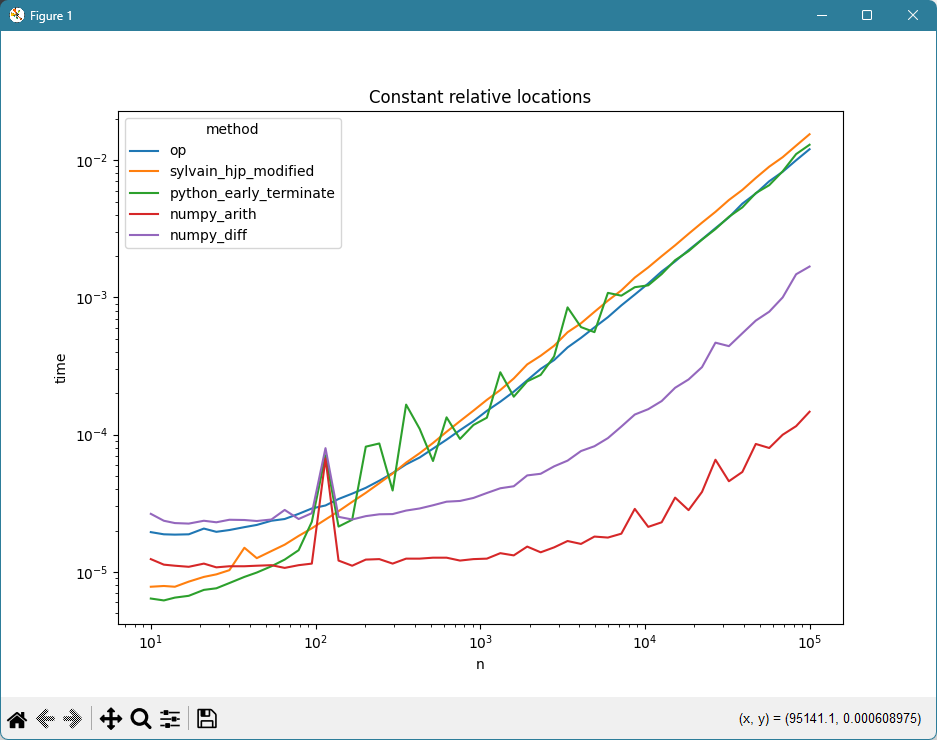I'd like to demonstrate a solution that differs from yours in the following ways:
Yours is written in pure Python. For arrays thousands of times larger than your current test case, there are performance advantages to instead calling into a C library with Python bindings like Numpy.
You can avoid an unconditional O(n) traversal as you're doing in your for loop. Instead,
- Sort, which is O(n log n) - but, in practice, has a much lower coefficient, then
- Iterate to find the gap between consecutive elements. This is worst-case O(n) but will usually terminate before getting to the end.
One Numpy version of (2) is to instead execute a discrete differential and then a bisection search to find the gaps and duplicates. diff is also O(n), but this can be mitigated if necessary by partitioning the input.
An advantage of this approach is that it can easily be modified to find all gaps and duplicates.
For example,
import timeit
import typing
import matplotlib.pyplot as plt
import numpy as np
import pandas as pd
import seaborn
def op(array: typing.Sequence[int]) -> tuple[int, int]:
""" returns the value of repeated number and missing number in the given array
using the standard formulaes of Sum of n Natural numbers and sum of squares of n Natural Numbers"""
x = len(array)
sum_of_num = 0
sum_of_squares = 0
sum_of_num_actual = (x*(x+1))/2
sum_of_squares_actual = ((x)*(x+1)*(2*x+1) ) / 6
for num in array:
sum_of_num += num
sum_of_squares += num*num
missing_num = (((sum_of_squares_actual - sum_of_squares) /(sum_of_num_actual - sum_of_num))
+(sum_of_num_actual - sum_of_num))/2
repeated_num = (((sum_of_squares_actual - sum_of_squares) /(sum_of_num_actual - sum_of_num))
-(sum_of_num_actual - sum_of_num))/2
return repeated_num, missing_num
def sylvain_hjp_modified(array: typing.Sequence[int]) -> tuple[int, int]:
sum_of_num = sum(array)
sum_of_squares = sum(n*n for n in array)
x = len(array)
sum_of_num_expected = x*(x + 1)//2
sum_of_squares_expected = sum_of_num_expected*(2*x + 1)//3
# Assuming A is present twice and B is missing:
# B - A
b_minus_a = sum_of_num_expected - sum_of_num
# B^2 - A^2 = (B-A) * (B+A)
b2_minus_a2 = sum_of_squares_expected - sum_of_squares
# B + A
b_plus_a = b2_minus_a2//b_minus_a
a = (b_plus_a - b_minus_a)//2
b = (b_plus_a + b_minus_a)//2
return a, b
def python_early_terminate(array: typing.Iterable[int]) -> tuple[int, int]:
increasing = sorted(array)
missing = None
duplicated = None
for x0, x1 in zip(increasing[:-1], increasing[1:]):
if x0 == x1:
if missing is not None:
return x0, missing
duplicated = x0
elif x0 + 2 == x1:
missing = x0 + 1
if duplicated is not None:
return duplicated, missing
def numpy_arith(array: np.ndarray) -> tuple[int, int]:
sum_of_num = array.sum()
sum_of_squares = array.dot(array)
x = len(array)
sum_of_num_expected = x*(x + 1)//2
sum_of_squares_expected = sum_of_num_expected*(2*x + 1)//3
b_minus_a = sum_of_num_expected - sum_of_num
b2_minus_a2 = sum_of_squares_expected - sum_of_squares
b_plus_a = b2_minus_a2//b_minus_a
a = (b_plus_a - b_minus_a)//2
b = (b_plus_a + b_minus_a)//2
return a, b
def numpy_diff(array: np.ndarray) -> tuple[int, int]:
increasing = np.sort(array)
diff = np.diff(increasing)
(i_dupe,), = (diff == 0).nonzero()
(i_miss,), = (diff == 2).nonzero()
return increasing[i_dupe], increasing[i_miss] + 1
METHODS = (
op, sylvain_hjp_modified, python_early_terminate, numpy_arith, numpy_diff,
)
def test() -> None:
for method in METHODS:
assert (1, 4) == method(np.array((5, 3, 2, 1, 1)))
assert (16, 7) == method(np.array((1, 2, 3, 4, 5, 16, 6, 8, 9, 10, 11, 12, 13, 14, 15, 16)))
# This test doesn't make sense: there is no missing value
# assert (1, 2) == method(np.array((1, 1)))
def benchmark() -> None:
times = []
for n in np.logspace(start=1, stop=5, num=50, dtype=int):
diffs = np.ones(n, dtype=int)
diffs[n//3] = 0
diffs[2*n//3] = 2
data = diffs.cumsum()
for method in METHODS:
def run():
return method(data)
t = timeit.timeit(stmt=run, number=1)
times.append({'method': method.__name__, 'n': n, 'time': t})
df = pd.DataFrame(times)
fig, ax = plt.subplots()
seaborn.lineplot(data=df, x='n', y='time', hue='method', ax=ax)
ax.set_xscale('log')
ax.set_yscale('log')
ax.set_title('Constant relative locations')
n = 1000
for loc in range(50, 1000, 50):
diffs = np.ones(n, dtype=int)
diffs[loc] = 0
diffs[loc + 2] = 2
data = diffs.cumsum()
for method in METHODS:
def run():
return method(data)
t = timeit.timeit(stmt=run, number=1)
times.append({'method': method.__name__, 'loc': loc/n, 'time': t})
df = pd.DataFrame(times)
fig, ax = plt.subplots()
seaborn.lineplot(data=df, x='loc', y='time', hue='method', ax=ax)
ax.set_title(f'Variable relative locations, n={n}')
plt.show()
if __name__ == '__main__':
test()
benchmark()




